ux
design
product
discoveryworkshop
What is Product Design?
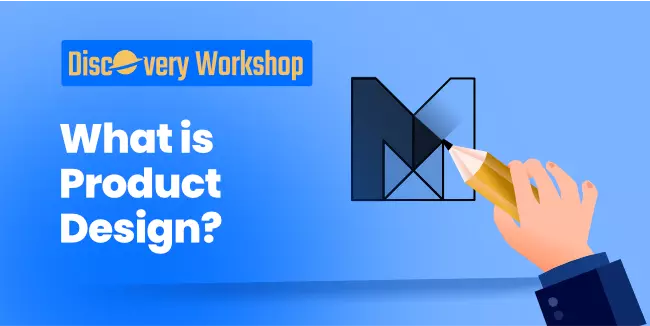
This article begins a series of articles about our endeavor, the Discovery Workshop. It is a series of studies to verify your idea/project in technical and business terms, with a small investment of time and money. To is an ideal solution for Startups and SMEs with an idea for a great digital product. The workshops are run by our experienced CTOs, whose knowledge goes beyond the books, and they are eager to share it with you.
A series of these articles will take you on a journey through every most crucial aspect of our workshops. They will present what we can offer you in an interesting form. This cycle is also a collection of tips and guideposts to help you achieve your desired goal when creating a product.
The following Product Design article is an introduction to our Discovery Workshop process. It is the first step to success that you can make with us. Avoid the risk, trust the specialist!
The Definition
Product design is the process of conceiving, developing, and iterating goods that meet users' problems or particular demands in a specific market. Understanding the end-user customer or the product's intended person is critical to good product design. Product designers look to address genuine issues for real people by putting themselves in their prospective customers' shoes and understanding their behaviors, frustrations, needs, and desires.
The perfect scenario is when the product design's implementation is so good that no one notices it. Users may use the technology as needed because, as you know from the user feedback, product design has anticipated their usage and satisfied their needs. Product design principles are present throughout the product lifecycle. Product design is critical in determining the user experience and product offering, from pre-ideation user research to concept development to prototyping and usability testing.
However, the process does not conclude since product design is continuously crucial in fine-tuning the consumer experience and ensuring that future functionality and capabilities are added in a seamless, discoverable, and non-disruptive manner. Brand consistency and evolution continue to be an essential product design responsibility until the end of a product's life cycle.
It's also much more than simply what users see on their screens. Behind-the-scenes components such as system design and process design ultimately influence users to notice and interact with the interface design.
Design Thinking
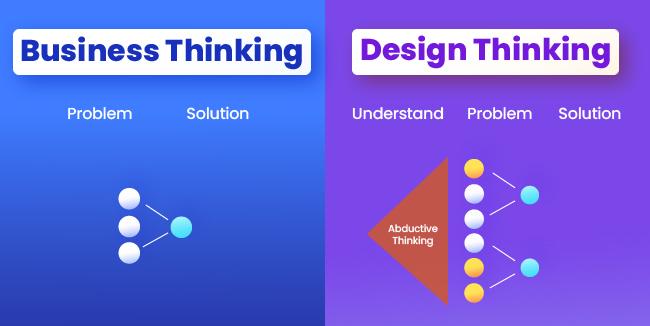
Design thinking is a process for dealing with issues practically. David Kelley and Tim Brown of IDEO coined the term "design thinking," which has become popular among product development firms. This concept unifies human-centered design methods and concepts into one idea. That human-centered approach utilizes the designer's toolkit to combine people, technology, and business success.
Good designers have always applied design thinking to product design. Being a Product Designer, you have to focus on the entire product development process, not just the "design phase" or simple visual elements.
When designing a product or feature, designers should first think about the company's goals and be able to answer the following questions:
- What problem are we solving?
- Who has this problem?
- What do we want to achieve?
Designers can use these questions to comprehend better the product user experience, not just the interaction (feel) or visual (look) sections of the design. After you've answered these questions, it is time to start searching for a solution.
And the solution cannot be easy, and when you feel in the dark, it is good to have a plan. Years of experience from many different product designers or people related to product creation have created an almost perfect plan. Such a plan has five phases:

- Empathize - Learn about the individuals for whom you're creating your design. To gain a deeper knowledge of your users, do research.
- Define - Create a point of view based on user needs and insights.
- Analyze - Think of as many innovative ideas as you can. Allow yourself and your staff complete freedom to develop a variety of options.
- Prototype - Make a prototype to test your theory. Creating a prototype allows the designer to see whether they're on the correct path, and it frequently produces unexpected thoughts.
- Test - Retrieve user feedback.
Product Design Process
Now that you know what design thinking is and that the design process is a sequence of actions taken by product teams throughout the creation of a product from beginning to end, you should know that having a well-structured procedure in place is essential for two reasons. First, It helps you stay focused and on track. Second, It assists you in staying on schedule.
While there is no such thing as a one-size-fits-all design process, it's still feasible to outline a typical flow for developing new goods. These are the following stages in this process:
- Define Your Product Vision
- Research The Product
- User Analysis
- Ideation
- Design
- Testing
- Maintaining
So it's best to start from the very beginning.
Defining Product Vision

The process of product design isn't simply about coming up with a good idea. One of the most crucial phases is completed before the design process begins. It's when the product team must define the product vision and product strategy. Before developing a product, you must first understand its context to succeed.
Have you ever worked on a project for which the overall objective was unclear? Unfortunately, this scenario comes to pass all too frequently. It usually happens because there is no vision for the product. In most situations, this has a negative impact at the final stage.
A product vision is required for each design project, and it serves as a roadmap to help the team navigate the process. Vision captures the essence of the product. The product team must know critical information to develop and market a successful item. Vision is an essential component in the process of visioning. It also aids in defining what you are not attempting to create. When developing your product, being clear on the parameters of your solution can help you stay focused.
But vision is only half of the picture. The other half is strategy.
The product strategy describes a product's route. Your vision enables you to define a destination, the ultimate user experience you strive for. You may plan your path to the target destination by focusing on what you need to create. Setting a goal, or a challenge, allows you to redirect your product efforts in the desired direction.
Here is an example strategy for making your vision real.
- Define Value Proposition - It explains key features like the product, who it is for, and how and where it will be used. It helps the team and stakeholders agree on what the product should be.
- Define Succes Criteria - It's critical to have a clear business objective when developing a product. It's crucial to speak with stakeholders about company goals and objectives for the project.
- Set Up a Project Opening Meeting - The opening meeting involves all of the essential players to establish clear expectations for the team and stakeholders. Also, when something is already planned, it's hard to withdraw from it and postpone it forever.
Research The Product
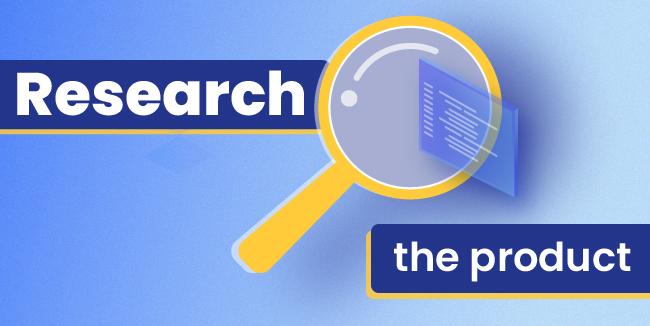
After you've established your product vision, the next step is to conduct product research, including user and market research. Before you make any goods decisions, perform comprehensive research. Remember that the time you put into researching is never wasted time.
Early in the design process, good research informs your product and saves you a lot of time and money in the long run. Plus, conveying your concepts to stakeholders will be easier if you conduct thorough research.
User research is critical for creating a great user experience. Conducting user studies allows you to figure out what your users want. Researchers have several options when it comes to product research.
There are a lot of different techniques of research. Gathering information through direct dialog is a well-known user research technique that can give the researcher rich information about users. User interviews can help the researcher assess user needs and feelings before designing and releasing a product.
Another way of effective research is surveys and questionnaires that enable the researcher to get a larger volume of responses, opening up the opportunity for more detailed analysis.
While online surveys are commonly used for quantitative research, they also can be used for qualitative research. Online surveys may be run rather inexpensively. The disadvantage of this approach is that there is no direct contact with respondents. Thus it isn't easy to go any deeper into their responses.
Another type of field research is contextual inquiry. The researcher watches people in their natural surroundings and examines them about their everyday tasks. This method allows researchers to learn more about the context of use by asking users a series of standardized questions, such as "What is the most frequent task you perform?" After that, researchers observe and question consumers while they work in their environment. The goal of the contextual study is to collect enough observations so that you may genuinely relate to your users and their points of view.
User Analysis
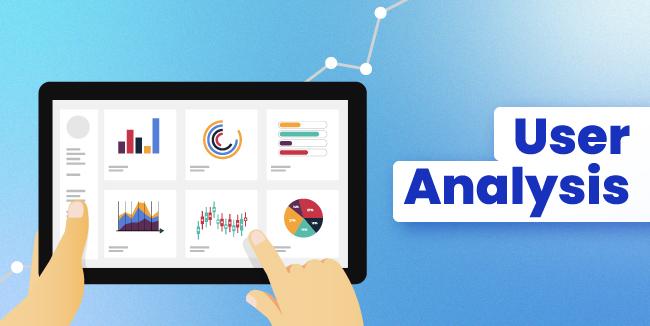
The goal of the analysis phase is to extract learnings from the data collected throughout the product study phase. After conducting research, the product team must make sense of its data. It's possible that capturing, organizing, and drawing conclusions about what users want, believe, or need might help UX designers understand why they want, think, or require something.
Personas are designed to serve as reliable and realistic representations of key audience segments for future reference. Personas are invented characters that serve as proxies for the various user types who might use a product in much the same way. UX designers and visual designers can use research findings to create representative personas and identify key user groups based on the product data.
After being built, personas assist product teams in comprehending users' needs in specific situations, which is particularly important during the ideation of the design process.
Remember to base the persona on real data because every bit of the information in the persona should be based on the research. If you don't have some information, research to fill in the gap.
It is crucial to make something called an "empathy map." A visualization tool articulates what a product team knows about the user. This tool allows a product team to understand the "why" behind users' wants and needs. It pushes product teams to refocus their attention away from the product they want to create and the people who will use it. When a team puts what they know about the user on a chart, they obtain a broader perspective on the user's world and problem or opportunity space.
Ideation
During the ideation phase, team members work together to generate inventive concepts that meet the project's objectives. As a product designer, It's critical to produce ideas during this stage and ensure that crucial design assumptions are correct.
There are various ways for product teams to ideate. You can start from sketching, which helps visualize some aspects of the design, to storyboarding, which illustrates the entire interactions with a product.
Generate ideas (How users will interact with the product) by creating a user journey map. It's most often depicted as a sequence of actions where users interact with a product. It illustrates the steps that a person would take to achieve a goal.
Depending on different companies' situations and business goals, a user journey may take many shapes. A timeline skeleton is used in its most basic form as a series of user steps and actions representing a user journey. This type of layout makes it easier for everyone on the team to comprehend and follow the user's story.
Your product design goals and aspirations also dedicate the technique you can use while a custom user journey mapping. You can use a couple of the most popular and recommended approaches.
Wireframing - It is a visual guide that represents a page's structure and its hierarchy and essential elements. Wireframing acts as the backbone of the product. Wireframes help discuss ideas with team members and stakeholders and to assist the work of visual designers and developers. Designers often use them as skeletons for mockups.
Sketching - It's the simplest technique to illustrate thoughts. Hand drawing is a quick approach to getting a concept across – allowing the designer to explore a broad range of design alternatives before deciding which one to go with.
Job Stories - A scenario is a description of something. It's a way to describe features from the perspective of a job-to-be-done. A job story is an effective method for defining a problem without prescribing a solution.
Design
After the ideation phase, the product team should grasp what they plan to construct. The solution to the client's problem and ideas will be developed during the design stage.
Prototyping
A prototype is a preliminary model of an idea that allows you to test it before developing the complete solution. A prototype usually starts small and grows in breadth and depth over several iterations as additional parts are added. The completed version of a prototype is given to development teams for completion.
Efficiency is critical when it comes to prototyping. Rapid prototyping is one of the most efficient prototyping processes. The rapid prototyping process can be broken down into three stages.
Prototyping entails creating a solution that may be examined and tested.
Reviewing by putting your prototype out to users and stakeholders and collecting feedback that helps you figure out what's working well and what isn't.
Refining based on the comments, and feedback, see what has to be improved or clarified. Your next design iteration's scope of work will comprise all the refinements in your list.
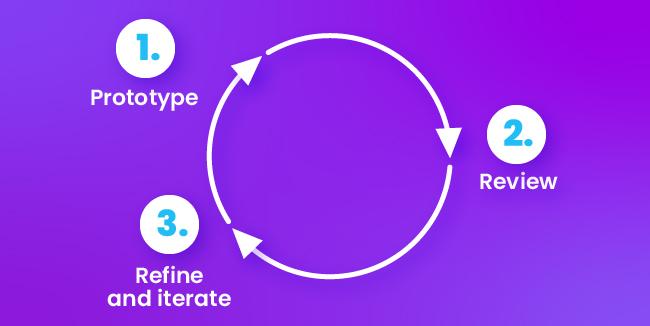
Prototypes are various representations that allow you to test how a product would appear and function in the real world. They range from low-fidelity prototyping tools and simple sketches on paper (low-fidelity prototypes) to interactive simulations that resemble a real product (high-fidelity prototypes). You must pick the appropriate prototyping approach to minimize work and maximize learning.
Sketching on paper, however, remains the most crucial tool for any designer. Sketching lets designers explore many different design options without spending much time and energy on each one. It compels product designers to focus on the product's design (what it does) rather than its aesthetics (how it looks).
What's especially great about sketching because it opens up design to everyone — anyone can sketch, and no special tools are required. Anyone who can participate in the design makes sketching an ideal tool during brainstorming sessions.
Testing

Product testing is an art in and of itself. A product team may use many methods to ensure that the design concept works as intended during the testing and validation. If you mess it up, you won't learn anything. Do it correctly, though, and you could discover fascinating, unanticipated insights that can alter your product strategy entirely.
The validation phase generally begins once the high-fidelity design is completed. Like the product research phase, this phase varies from project to project.
A usability test is a method for assessing the design of a product to see whether it functions effectively with the target users. It's simple to conduct a preliminary test of a concept with mock users: A product team would be able to observe how the intended demographic uses the product after an interactive version of the innovation has been delivered into their hands.
This user experience testing approach aims to find usability issues, gather qualitative information, and assess participants' overall satisfaction with the product. Verbal and non-verbal comments from the user may assist a product team in producing a better user experience by gathering and analyzing both vocal and non-verbal data.
Usability testing is frequently done formally, with a researcher developing a screener, recruiting participants, bringing them to the lab setting, recording the session, etc.
A diary study may examine how consumers use a product over time (from a few days to even a month or more). Study participants are asked to keep a diary and record precise details regarding their actions.
Maintaining
It is probably the simplest phase, for some the simplest, but some people will miss such a basis in the entire crowd of product design tasks.
The product design isn't finished just because a product has been announced. Creating a product continues as long as that item is in use. The group will learn and grow with the product.
The quickest approach to getting out of a situation like this is to provide input into the process. User feedback (through online surveys or analysis of customer support tickets) should be incorporated into the creation process. Using existing user data will drive product improvement forward. Make it easy for consumers to provide comments. Don't try to hide the "Leave feedback" option. Make it as simple and rewarding as possible for customers to express their thoughts and ideas about your product.
Conclusion
While we conducted a rather rigid and linear design process, you may find yourself traveling back and forth to learn more about the issue domain.
A product design process should change to match the project, not the other way around. The design process you use will depend on where the feature or product is along the product development lifecycle. In other words, if your product is in its early phases, you might want to do more user testing. In contrast, if it has already been released, you may want to focus on growth and optimization.
Keep refining and enhancing your product because that is at the heart of what we do! Once a product has been produced, never assume it is complete. Continue to seek input and improve your creation as users' demands evolve.
Finally, the essential thing to keep in mind when creating a product design is that we are designing something for people to use. We play a crucial role in determining your own and someone else's future as product designers.

This article is part of our Discovery Workshop series
Now readingWhat is Product Design? What is the Product Discovery and Product Discovery Process? Tips and Techniques for Effective Product Discovery Process Idea Validation in Practice Product Roadmap - how to write user stories and user flows? How to choose a tech stack for your project? How to create a project timeline? How to create a project budget? Functional Requirements Document for your Product What is a Prototype? Build your MVP (Minimum Viable Product) the right way - step by step guide by mDevelopers